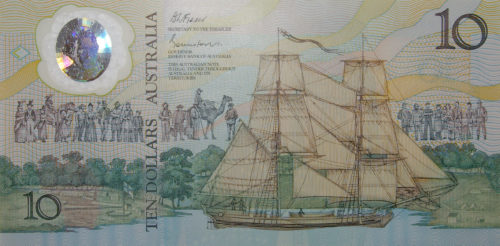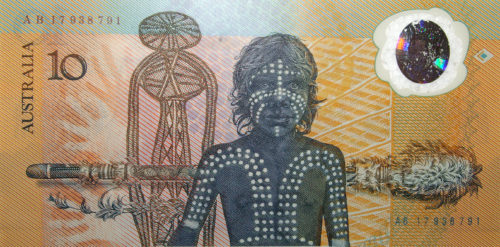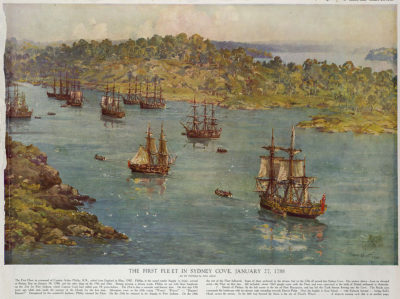P029
Polymer, UNC
167 x 78 mm (6-1/8” x 3-1/16”)
HISTORY: On his 1770 voyage of discovery, James Cook (1728‒1779)—a captain in the British Royal Navy, an explorer, and a cartographer—was the first to sail the western Pacific Ocean and chart the eastern coast of the largest land mass of Oceania, which became known as the continent of Australia.
Meanwhile, the 13 colonies on the eastern seaboard of the New World, under British rule, were brewing revolutionary fervor against oppression and taxation. British law was ruthless in its homeland, sentencing harsh terms to its own citizens for even minor offenses. For shoplifting a dress or scarf, or stealing a loaf of bread, a person (man, woman, or child) could be sent to the gallows or transported.
The colonies supported several British penal institutions where criminals were transported to do their time. As the American War of Independence raged through the years from 1775 to 1783, these penal prisons continued to operate. Following the British defeat, however, those prisons were shut down in the newly independent nation.
The British government began looking for other locations for their penal colonies. It was too costly to fund and operate prisons in England, so these colonies were an expedient means of sweeping the riffraff under the carpet of social decency. They chose a faraway destination: Sydney Cove, Port Jackson, in what is now the eastern coast of Australia.
An armada of sailing ships known as the “First Fleet” was assembled under the command of Admiral Arthur Phillip (1738‒1814), who was tasked with the transportation of over a thousand prisoners and the establishment of a new penal colony in this distant land. The voyage took eight months, finally arriving at Sydney Cove in January 1788, where Admiral Phillip set up camp and raised the flag of England.
The creation of Port Jackson inspired an influx of European settlers who were looking for farm and grazing land. However, it was not until 1813 that exploration into the interior lands beyond the coastal Blue Mountains had begun. In 1826, Great Britain claimed the entire continent as their own, although much of it was unexplored. Many of the regions beyond the mountains were semi-arid and desert.
The idea of introducing camels to the continent was bandied about in 1839 and, by 1840, they began importing the animals from British India and Afghanistan. A new influx of skilled immigrants also arrived with their families and tools.
OBVERSE: Of the “First Fleet,” the brig Friendship—beautifully engraved on this colorful, 10-dollar note—was the smallest ship with a length of 75 feet and a beam of 23 feet. Built in Scarborough, England, and launched in 1784 as a convict transport, it carried 76 male and 21 female prisoners to Sydney Cove. (Actually, the women were transferred to the Lady Penrhyn on a resupply stayover at the Cape of Good Hope to make room for livestock.) It also carried a contingent of a captain, two lieutenants, three corporals, one drummer, 36 privates, and an assistant surgeon for the new colony.
Above the tree line is an array of immigrants to the new frontier, along with the arrival of the camel, 52 years after the establishment of the penal colony. As a tip of the hat to their early explorer, Captain James Cook’s holographic portrait is shown in the upper left corner.
REVERSE: Humans moved into the Oceania continent some 65,000 years ago. Aboriginal cultures, considered the oldest continuous civilization on Earth, developed approximately 15,000 years later as they took up residence throughout the landscape. This note pays tribute to the aboriginal peoples with a riveting portrait of a young warrior painted with the creative dot patterns used by indigenous communities of central Australia. Behind is a feather-tipped didgeridoo and woven figurine. A holographic Captain Cook looks down from above left.



